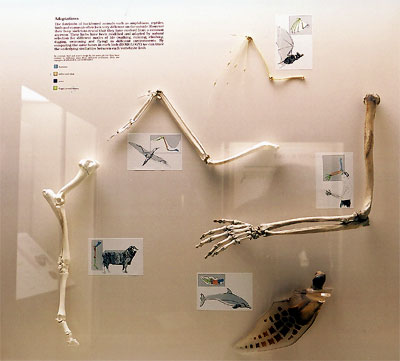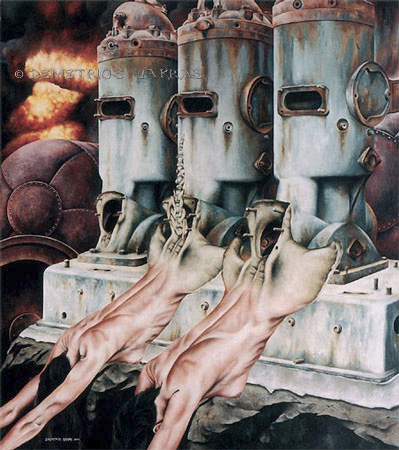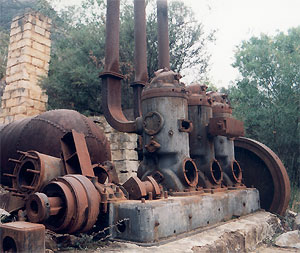|
ON ART OF THE IMAGINATION
Historically art of the imagination finds itself in favour spasmodically, only to be eclipsed for long durations by art which either copies its models directly from nature; or as was the case for the main part of the twentieth century, finds its models in the non-figurative.
Andre Breton lamented on the eclipse of the nineteenth century's practitioners of art of the imagination, the symbolists (mortal enemies of the impressionists & Zola) and famously proclaimed that the appreciation of their art was blocked by the level crossings of nothing.
History tends to be circular and today the boom gates of the level crossings have been lowered yet again.
In a nation like Australia where the artistic cause celebres have been those whose horizons never quite rose above nationalistic themes you might expect that the imagination would be overwhelmed or extinguished. Fortunately this has not quite been the case, but only just.
demetrios vakras
|
Introduction to my solo exhibition at Roar Studios in Melbourne 1 - 13 June 1999.
INTRODUCTION TO EXHIBITION
The paintings in this exhibition span a time-frame of 21 years worth of effort. The recent computer work was a result of 8 weeks worth of sitting before a computer, creating in that short time approximately 3-4 years worth of my usual output of paintings.
The paintings basically all belong to my 'apocalypse' phase where humanity was to be stripped bare of dignity and meaning with the pointlessness of it all exposed. I have progressed though. My paintings now show that the immutability of objects whether animate or not, human or not, mechanical or not, can be breached in the visual sphere. After-all, all biology shares the same make-up: we are all composed of cells, which die constantly and are replaced constantly. And when we die, on the cellular level, that which does die is a completely different entity to that which was born. The cells we were born with have died and been replaced many times over. Basically we never are but are always in a state of becoming. Ultimately we are all composed of matter, nothing more than encapsulated quanta of energy. Everything ultimately is interchangeable.
Although in the past [my work included] representations of human birth and 'nurturement' of human foetuses by machinery [intended] to express the 'choice', or rather, lack of choice in being born into this pointless existence, those elements have disappeared. I do not anymore belabour the point of the involuntary nature of being born and the mindless perpetuation of this imposition of the same fate to others that have yet to be born by those that are born. Although my visual iconography has remained the same my more recent works simply reconstitute the animate with the inanimate, and within the animate 'bits' from nonrelated species become interchangeable. *[refer notes, below]
On a technical and artistic level I disagree with the notion that art should not be figurative, or that there should merely be “hints” within the painting with the rest left up to the viewer to interpret. If you have no idea you hope that your viewer invents one for you. It is a lot more difficult bringing incongruous elements together and making them appear to belong together, balance the composition so that it is not a random and poorly executed photomontage, than it is balancing abstract forms and colours. You have to begin with an idea, you have to build on it and you have to be capable of pulling it off. This is hard work! It can take anything from a week or two to reconcile a composition: make it work, after that it has to be drawn on the canvas, and then painted, a process that can take 4 - 9 weeks. I still find myself painting on images that I drew in my sketchbook in 1993-94.
Neither do I have time for what is mistermed as 'experimental art'. The purpose of any experiment is to provide an empirical basis for either the validation or refutation of a particular contention; an experiment proves or disproves. Thus an experiment once done need not be repeated over and over just for the sake of performing it! It is nothing more than a self-serving and pointless self indulgence.
* NOTES: Nature uses a similar process in the evolution of species...: "...the forelimbs of vertebrates which, whether they serve reptiles, birds, whales or man, show the same basic design of bones, muscles, nerves...The functions of legs, wings and flippers are quite different, yet they all are variations on a single theme: strategic modifications of a pre-existing structure... Once Nature has 'taken out a patent' on a vital organ she sticks to it... while its adaptation to swimming, walking or flying is a matter of evolution's flexible strategy." p204, Chapter XI "Strategies and purpose in evolution", from the book JANUS A summing Up, by Arthur Koestler isbn: 0 09 132100 X.
The point is best illustrated in the photograph (below) taken at the Austalia Museum, Sydney.

The text in the photograph reads: "The forelimbs of backboned animals such as amphibians, reptiles, birds and mammals often look very different on the outside. However their bony skeletons reveal that they have evolved from a common ancestor. Their limbs have been modified and adapted by natural selection for different modes of life (walking, running, climbing, digging, swimming and flying) in different environments. By comparing the same bones in each limb (HOMOLOGY) we can trace the underlying similarities between each vertebrate limb."
Explanatory essay accompanying the painting Post Industrial Muses at the Amalgam Exhibition at 4Cats Galley 9-27 April 2002

|

POST INDUSTRIAL MUSES
Paintings sometimes develop as a consequence of forms suggested....
In this painting forms are suggested by the machinery.
The work has to be consistent with the visual iconography of past works. The machinery can accommodate bony structures at any point. This painting, one of several versions based on what are abandoned steam-engines at an old disused rock-quarry at the Grampians (Victoria Australia), shows bony appendages evolving into the muses.
|
|
Other versions have bony appendages developing at other points but devoid of any human element. In this painting the figures evolve from the machinery. The title is actually an afterthought.... The figures appear as muses, created by an industrialised culture then abandoned. The explosion in the background adds drama. It was selected because it looked good. Sometimes critics and viewers have to accept that aesthetics come before psychology..... which means that the psychoanalytical approach, quite popular for most of the last century, was more a betrayal of various critics’ own perceptions... and hardly relevant in the analysis of either the art in question or the artist who created it.
|
|
Introduction to my work for the joint exhibition (with school-friend-artist Heather Robinson) at Roen Gallery in Melbourne 15-26 June 1981
PROLOGUE OF EXHIBITION
Art is a medium of self-expression. Through it the artist displays another dimension of himself, and through it the artist is able to gain a greater understanding of himself and/or perhaps the world around him. Better artists are capable of interpreting feelings, perceptions, ideas, in visual imagery. True art is an extension of the artist's self and an extension of his beliefs, ideas, conceptions. True art possesses the psychological, the 'spiritual' depth that transcends the mere visual image with the artist in possession of the ability of expression of an inner depth, an inner reality with the capability to transcend reality and reach a goal far beyond the immediate visual image.
My art strives for this inner meaning, to transcend reality, interpret my own inner perceptions, ideas. My later works which are not here but are pencil sketches, come closer to this. The inferiority of my own art which is exhibited lies in my own inability to render in colour the 'feel' originally intended in the pencil sketch, usually ending up with a painting which evokes an entirely different 'feel', which lacks impact, the discomforting atmosphere of the pencil sketch.
Often the public seeks 'meaning' unable to realise that the depiction of the commonplace [landscapes, still-lifes, etc] has no meaning. Art is not supposed to 'mean' anything. Art is an expression. I compose and express to the best of my ability.
Art is evident when the artist looks into himself, his inner-personna, his psychology and allows these inner motivations outward expression.
Art is at best, expressed by way of intuition and an artist, certainly those better than myself, possess visionary power and intellectual strength which I am only now beginning to develop.
|
|

![]()

![]()